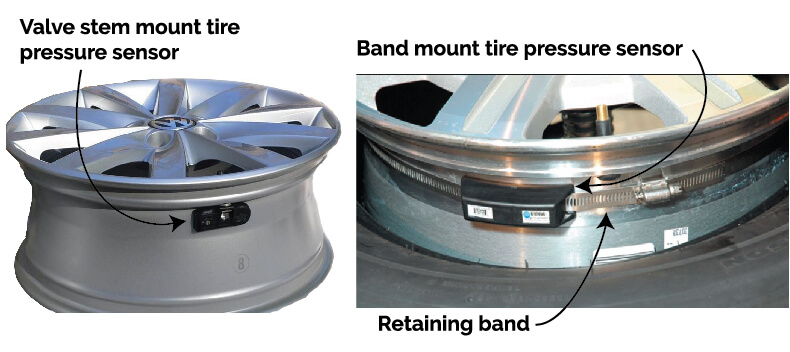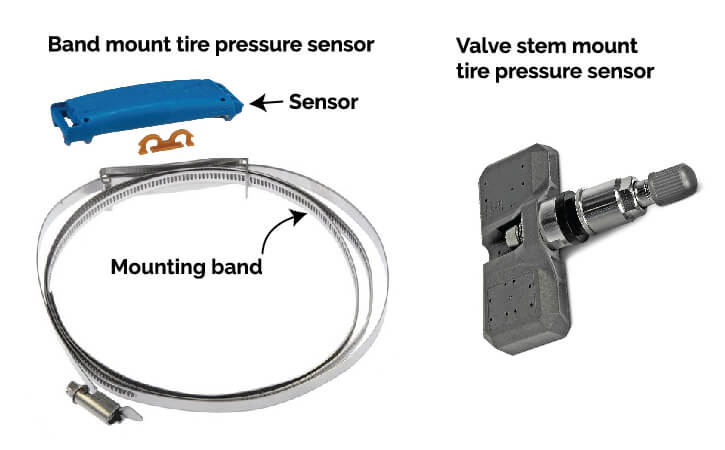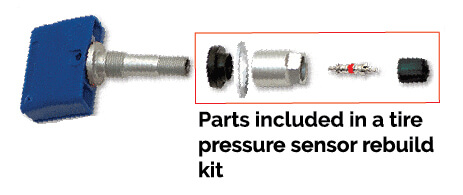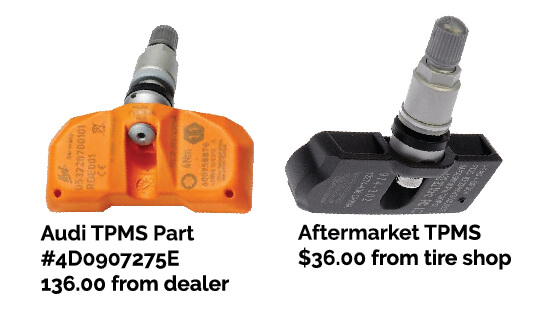Do I Really Need a Tire Pressure Sensor Rebuild?
Is a tire pressure sensor rebuild really necessary?
If you’re asking the question, it means you’re getting new tires and the tire shop wants to rebuild your tire pressure sensors. You want to know if you really need a tire pressure sensor rebuild? The short answer is yes. A tire pressure sensor rebuild should cost about $10 per wheel and is worth every dime. Read on for more information.
What is a tire pressure sensor?
All vehicles made after Sep. 1, 2007 must have a tire pressure monitoring system (TPMS) to alert the driver to a low tire pressure condition. Each car maker is allowed to set their own pressure threshold at which point the low tire pressure indicator shows on the dash. But the tire pressure warning light must illuminate when tire pressure reaches a pressure that’s 25% lower than the car maker’s recommended pressure. Driving a vehicle with low tire pressure is dangerous because  it causes the tire’s sidewall to flex and heat up, possibly causing a blowout. The most recent surveys conducted by the National Highway Traffic Safety Administration (NHTSA) conclude that tire failures cause approximately 11,000 crashes a year. In addition, low tire pressure dramatically decreases the vehicle’s stability and stopping power. Under-inflated tires or worn-down treads are a major cause of failure. If that isn’t enough reason to stop and inflate your tires when the light comes on, you should know that low tire pressure also decreases your gas mileage and wears out your tires much faster.
it causes the tire’s sidewall to flex and heat up, possibly causing a blowout. The most recent surveys conducted by the National Highway Traffic Safety Administration (NHTSA) conclude that tire failures cause approximately 11,000 crashes a year. In addition, low tire pressure dramatically decreases the vehicle’s stability and stopping power. Under-inflated tires or worn-down treads are a major cause of failure. If that isn’t enough reason to stop and inflate your tires when the light comes on, you should know that low tire pressure also decreases your gas mileage and wears out your tires much faster.
Tire pressure sensors are available in two styles; valve stem mount, and band mount (see the photos)
Both types have a pressure sensor and a sealed battery. Car makers estimate battery life at around 7 to 10 years and it’s not replaceable because it’s sealed with epoxy to prevent corrosion. When the battery dies, you must replace the entire pressure sensor. In addition to a pressure sensor, the unit also includes an acceleration and temperature sensor (air pressure varies  depending on temperature) and a transmitter to send pressure readings to an antenna located in the vehicle. The sensing and transmission protocols vary by car maker. For example, in late model GM vehicles, the sensor takes a pressure reading every 3-secs. when the acceleration sensor determines the vehicle is stationary. If it senses a tire pressure variation of more than 1.2-psi since the last measurement, it’ll take another measurement to confirm. It it still reads low, it’ll transmit to the antenna. In other brands, the sensor goes to sleep when it senses the vehicle is stationary and wakes up when the acceleration sensor detects movement. The sleep mode is designed to extend battery life.
depending on temperature) and a transmitter to send pressure readings to an antenna located in the vehicle. The sensing and transmission protocols vary by car maker. For example, in late model GM vehicles, the sensor takes a pressure reading every 3-secs. when the acceleration sensor determines the vehicle is stationary. If it senses a tire pressure variation of more than 1.2-psi since the last measurement, it’ll take another measurement to confirm. It it still reads low, it’ll transmit to the antenna. In other brands, the sensor goes to sleep when it senses the vehicle is stationary and wakes up when the acceleration sensor detects movement. The sleep mode is designed to extend battery life.
Why does a tire pressure sensor need to be rebuilt?
Valve stem style tire pressure sensors mount to a hole in the wheel and seal in tire pressure with a rubber gasket. Over time, the rubber gasket can deteriorate and leak. In addition, the valve stem itself has a spring loaded valve core that allows you to add air. The seal on the valve core can also degrade over time. Finally, the tire pressure sensor is secured to the wheel with a metal “nut.” The valve stem threads and nut are exposed to rain and road salt, causing them to corrode or time. For all these reasons, tire shops recommend rebuilding the tire pressure sensors every time you change tires, since the rebuild procedure must be performed with the tire removed from the wheel. If you opt out of the rebuild job and experience a leak in the tire pressure sensor’s sealing gasket, you’ll have to pay to remove the tire.
Frankly, experience since 2007 shows that very few seals ever leak. However, corrosion between the threads and the securing nut has become a major problem. Once corrosion sets in, you can break off the entire valve stem simply by adding air to the tire. It has become such a problem that many shops now warn you of the possibility before they’ll even rotate and balance your tires and check air pressure. If the tire pressure sensor breaks, you must replace the entire sensor and pay for the replacement yourself. The shop will not be responsible.
What is a tire pressure sensor rebuild?
Once the tire is off the wheel, the shop unscrews the retaining nut (see photo) and discards it. Then they remove the sensor assembly from the wheel so they can remove and discard the rubber seal. Next, they install remove and discard the valve stem core. The technician then obtains an appropriate tire pressure sensor rebuild kit to match the tire pressure sensor used in your vehicle. The rebuild kit for tire pressure sensors usually includes a new rubber seal, washer, securing nut, valve core, and valve stem cap.
The technician replaces the seal, washer, core, and nut with the new components and re-assembles the tire pressure sensor to the wheel. Finally, they secure nut using a special torque wrench because over-tightening can damage the sensor and under-tightening can result in leaks.
The $10 charge per wheel covers the parts and labor.
What if you don’t approve the tire pressure sensor rebuild charges?
If you decline the tire pressure sensor rebuild, you assume all liability for future air pressure leaks.
What if you need a new tire pressure sensor?
If you have your tire rotations performed at the dealer and the tire pressure sensor breaks or the battery fails, the dealer will replace it with an (OEM) part. OEM TPMS sensors range from $50 to well over $200. But many companies make aftermarket parts sensors that perform just as well as the OEM units for a fraction of the price (like $25). I’ve listed a few of those below. The downside to installing an aftermarket sensor is that they generally require software programming with a universal TPMS programmer—something the dealers don’t have. However, tire shops DO have those tools, which is another reason why you shouldn’t buy tires at the dealer or have tire service done at the dealer. If the dealer informs you that you need a new tire pressure sensor and the sensor cost is high, contact a local tire shop and ask for a quote for a new aftermarket TPMS including labor and programming. That can save a bundle.
©, 2016 Rick Muscoplat
Posted on by Rick Muscoplat



